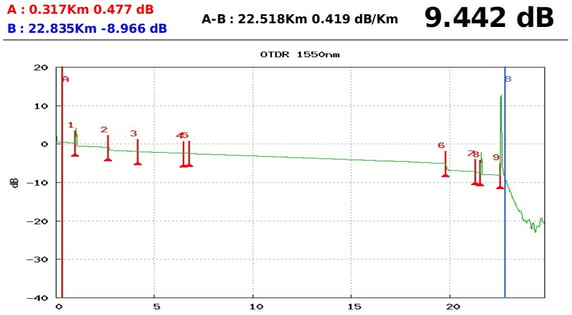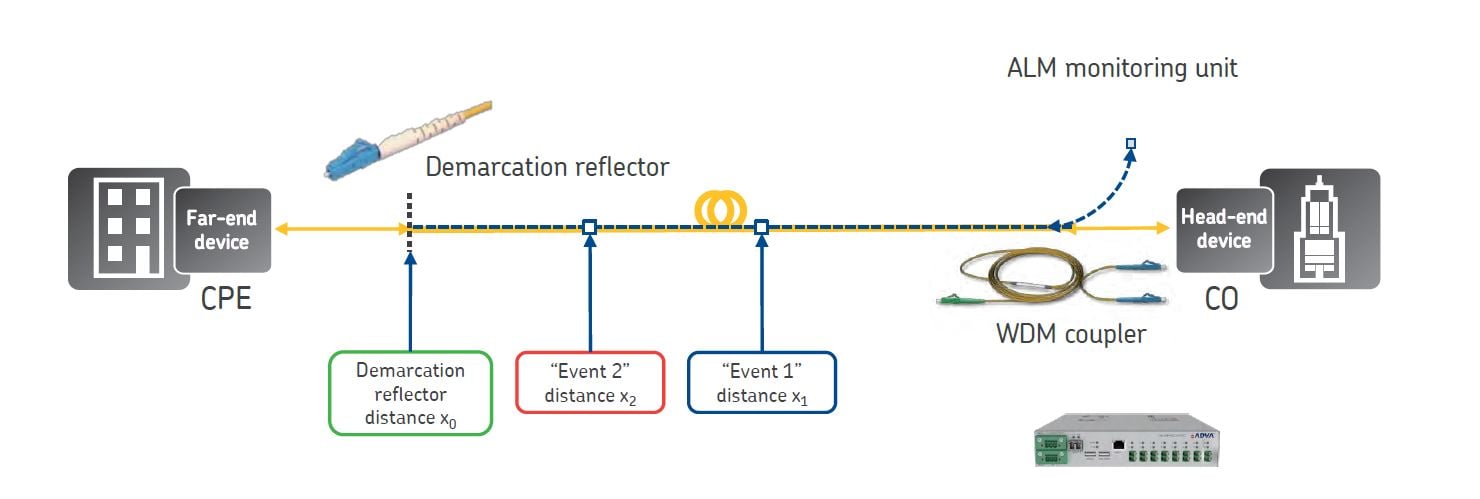Career 15 Vacancies 250+ Employees
Career 15 Vacancies 250+ Employees
InfoGuard AG (Headquarter)
Lindenstrasse 10
6340 Baar
Switzerland
InfoGuard AG
Stauffacherstrasse 141
3014 Bern
Switzerland
InfoGuard Deutschland GmbH
Landsberger Straße 302
80687 Munich
Germany
It is time to change how fibre optics are monitored

From short to very long distances, fibre optic networks are the leading media for the high-speed transmission of data. Network downtime due to fibre damage can be business-critical. It is therefore imperative to take immediate action! Without accurate information as to the cause of the problem, it is impossible to carry out the necessary error analysis needed in a speedy recovery. Today it is possible to monitor optical fibres during normal operation without hindering the transmission of data, and thus avoid downtime.
Defective or damaged fibre can be business-critical. This means that companies and service providers must be able to quickly identify and precisely locate problems in the fibre-optic network so that repairs can be carried out as efficiently as possible. A traditional OTDR (Optical Time Domain Reflectometry) measurement can be very helpful, as it provides accurate changes in the profile of a fibre. In OTDR measurement, laser pulses lasting a few nanoseconds are coupled into the glass fibre and the backscattered light is measured over time. This means that losses caused by splicing, reflections from connectors, the attenuation of the glass fibre and so potential damage or even interruptions can be detected to within a few metres.

Graphic: Loss profile of a glass fibre by OTDR measurement
The major disadvantage of the classic OTDR measurement is that it is just a snapshot. In addition, it is necessary to interrupt data communication over the fibre at both ends. Ideally, an OTDR measurement should not just be used once (e.g. when setting up the network), but used as permanent monitoring tool. The question is, is it possible to carry out such an operation during the normal transmission of data?
Fibre Link Monitoring – how does it work?
The good news is that yes, it is possible! Innovations in optical components and digital signal processing have provided the basis for an economically viable fibre monitoring system. Similar to the OTDR measuring device, a monitoring unit emits a laser pulse on a dedicated wavelength and then measures the backscattered light. This wavelength is outside the normal wavelength spectrum deployed for the transmission of data (C-band, approx. 1530nm-1570nm), typically 1650nm. Coupling this test signal by means of a filter at one end of the glass fibre the resulting backscattered light is then reflected at the far end and measured. As the test signal runs on a dedicated wavelength, it has no influence on production data and so enables simultaneous measurement and continuous network monitoring. This technology provides the bases for permanent fibre-optic monitoring tool.

Set reference measurements - known as a fingerprint are recorded during the initial monitoring process. Throughout the monitoring process, measured loss profiles are compared with the fingerprint. An alarm is triggered immediately should defined threshold values be exceeded. By using the detailed data from the monitoring device, the cause of a deviation can be determined immediately and pinpointed to within a few metres. By coupling this it with a Geographic Information System (GIS), it is possible to display the map location of a problem.
4 compelling benefits for using an in-service monitoring solution
- Optical Network: Real-time network information. Enabling rapid fault detection and dramatically reducing time for repairs.
- No interruption in network operations. Simultaneous real-time measurements during normal unimpeded data transmission.
- Early stage detection of any degradation in fibre quality (e.g. due to ageing). Enabling proactive action before a possible service failure.
- GIS quickly provides error location and possible cause allowing the effective deployment of service teams thus saving time and resources!
The benefits for those responsible in securing networks cannot be underestimated, but in-service monitoring can provide even more benefits!
Monitoring maintenance points with in-service monitoring
Common vandalism, structural damage etc. can range from removing a cover to cutting cables. By using fibre sensors, it is possible to monitor maintenance points along a fibre link - even when they have no power connections. Fibre sensors convert mechanical stress into attenuation, which can then be remotely monitored. A wide range of sensors is available and includes monitoring torsion, temperature and humidity. Regardless of whether providing a service or using a dedicated private network, in-service monitoring offers many benefits and is becoming an essential component in managing, operating and servicing complex fibre optic networks.
Advanced Link Monitoring (ALM) – simple and efficient
Are there any drawbacks? Unbelievably there are no drawbacks! Acquiring real-time information of the integrity of the fibre optic network does not involve new, costly investments. The Advanced Link Monitoring (ALM) system from our partner ADVA Optical Networking combines these benefits and radically changes the monitoring of fibre networks. Would you like to learn more about this revolutionary solution?
Blog

Incident Response Planning (IRP): Gut vorbereitet, stark im Ernstfall

Zero Trust Maturity Model 2.0: Reifegradmodell auf 5 strategischen Säulen


